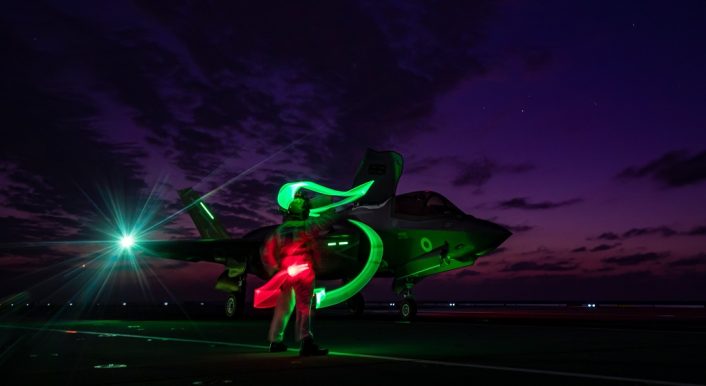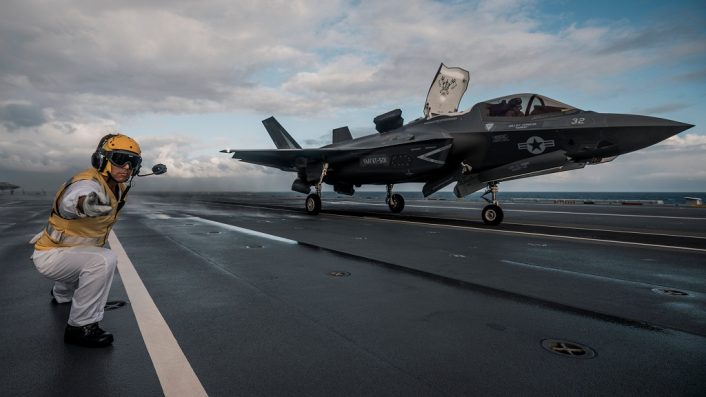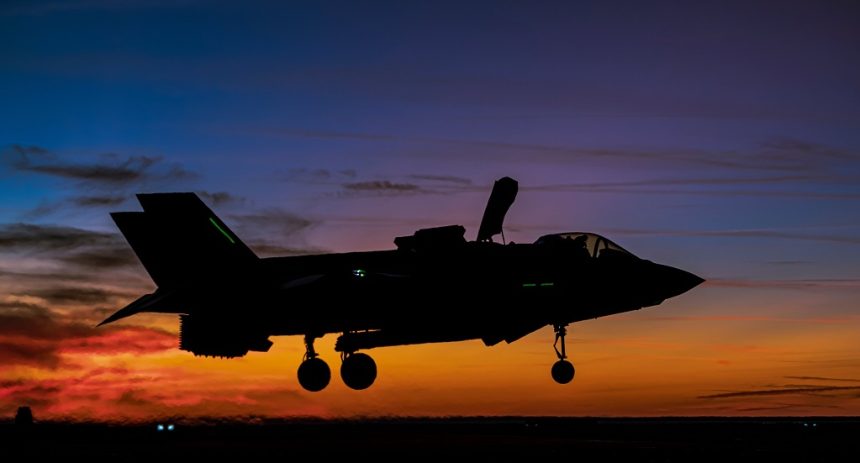The Lightnings recently started night operations after being joined by the USMC F-35Bs.
The Royal Air Force and the Royal Navy are currently involved in the Westlant 19 cruise off the East Coast of the United States to test the F-35B in an operational environment aboard the HMS Queen Elizabeth. After the initial carrier qualification during daylight, the pilots are now undergoing the night carrier qualification process.
In a modern conflict scenario most of the operations, especially the initial attack missions and special operations, are conducted during night time to reduce the exposure of friendly assets and to exploit surprise effect and night vision technologies, so it is very important that pilots and support personnel can perform their missions confidently also at night.

The Royal Navy posted on the official Twitter page for the HMS Queen Elizabeth on November 8, 2019 some photos of the night qualification currently going on aboard the ship. The particular light conditions during which the training took place resulted in some really stunning photos.
Want to see a busy flightdeck? Enjoy this great video by Leading Photographer Dan Shepherd, of @USMC #F35 pilots from VMX-1 carrier qualifying on our deck. Preparations for our first operational deployment with 🇬🇧& 🇺🇸Lightnings embarked in 2021 are in full swing #WESTLANT19 pic.twitter.com/xJUWM3K4Ej
— HMS Queen Elizabeth (@HMSQNLZ) 1 novembre 2019
Recently, F-35Bs from the US Marine Corps joined the British Lightnings on the carrier. According to the Royal Navy, the pilots deployed on the ship are from the MCAS Yuma-based VMX-1, which is overseeing the operational evaluation of the F-35B in the USMC. Interestingly, the jets depicted in the photos aboard the HMS Queen Elizabeth are from VMFAT-501, based at MCAS Beaufort, so it’s possible that VMX-1 took the jets on loan from Beaufort to simplify the logistics, instead of bringing their own jets from Arizona to the East Coast.
Here are some more of today’s very welcome new additions to #WESTLANT19 ; @USMC and their #F35 Lightnings onboard – that’s two VMX-1 pilots already daytime carrier qualified 👊🏼 And yes, there will soon be video! #QNLZatSea #bigdecksfastjets @RoyalNavy @RoyalAirForce pic.twitter.com/u6e0Wr0H7v
— HMS Queen Elizabeth (@HMSQNLZ) 31 ottobre 2019
The integration of Marine F-35B pilots on the HMS QE is not as straightforward as it could seems, even if they are already carrier qualified. There is, in fact, an important difference between the British carrier and the Wasp-class LHDs and America-class LHAs from where USMC F-35Bs usually operate: the ski-jump. Wasp and America classes’ ships are flat-top carriers, so Marines that are going to deploy on the HMS Queen Elizabeth in 2021 will have to get accustomed to the ski-jump first.

The ski-jump disadvantage that made not possible its usage in the USMC is the space needed for its installation on the ship, which limits the space available to park aircraft. The advantages of the ski-jump far outweigh the disadvantages for two important reasons. The first one is that the ski-jump is safer than the flat-top, as the aircraft will certainly take off with a positive rate of climb; the second, equally important, is that the ski-jump allows a greater takeoff weight than the flat-top, which means that the jet can launch with more fuel and munitions.
There are some great lighting conditions for our @RoyalNavy photographers as we night qualify our F-35 pilots here off the East coast of the USA. Rotary wing flying continues too as we pound the decks around the clock #WESTLANT19 @RoyalAirForce @17SqnRAF @OC617Sqn @CdrBobBond pic.twitter.com/iodsZt1245
— HMS Queen Elizabeth (@HMSQNLZ) 8 novembre 2019
Similar flight operations with the use of the ski-jump will be conducted in future by the Italian Navy F-35Bs aboard the Cavour aircraft carrier, which is undergoing an extensive overhaul and receiving upgrades that will allow it to operate with the F-35B. The ship is expected to deploy to the US East Coast in 2020 to perform a test campaign similar to the British Westlant 19.









